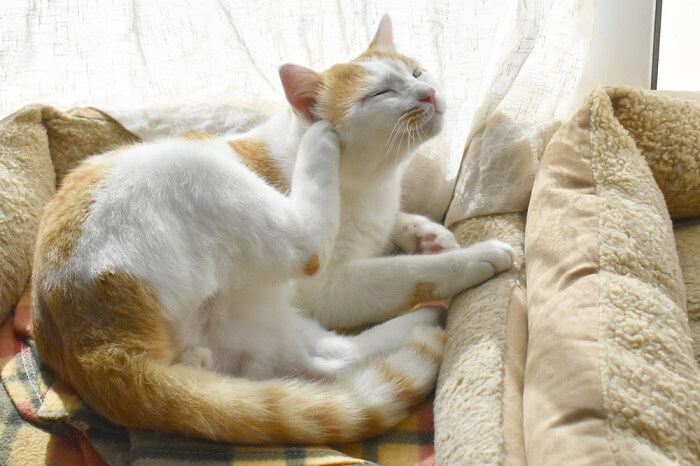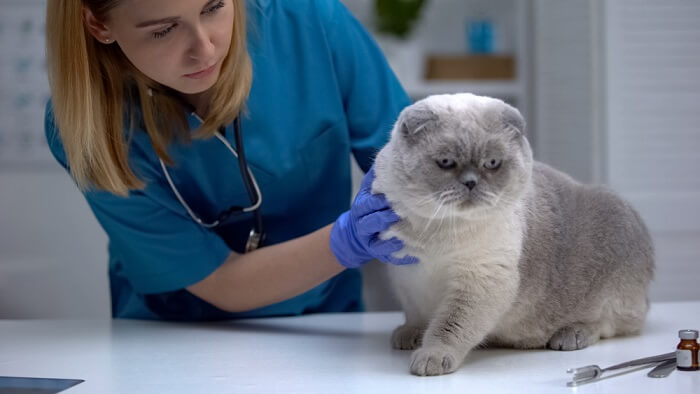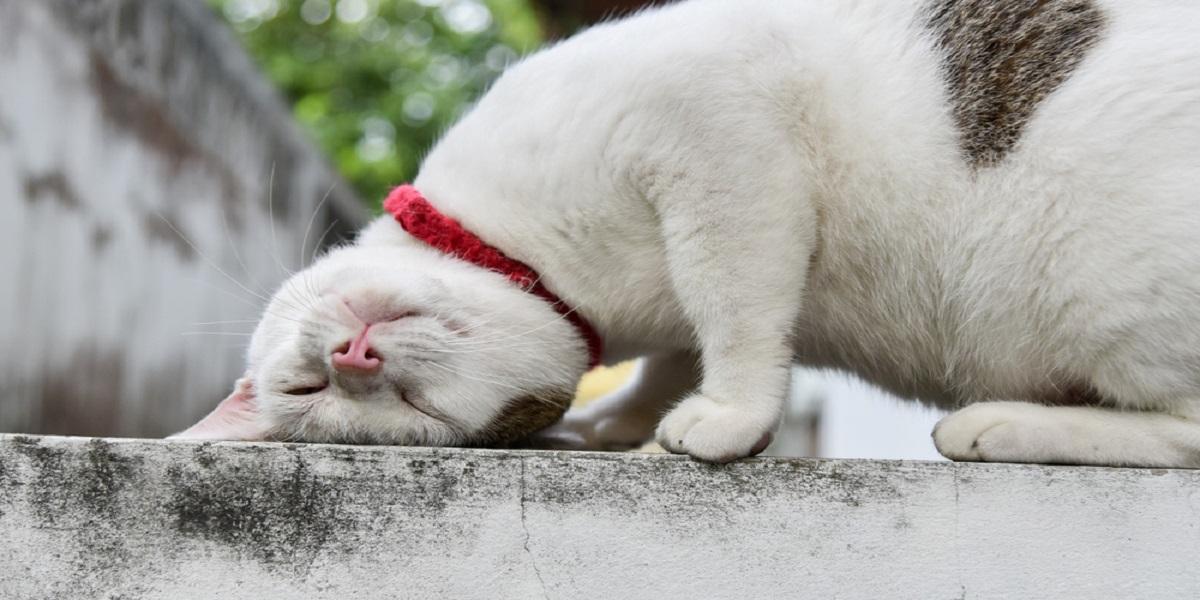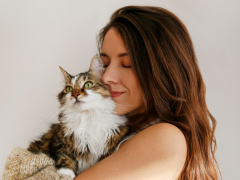Quick Overview: 'Mad Itch' Pseudorabies Virus Infection in Cats






What Is Feline Pseudorabies?
Feline pseudorabies is a rare disease caused by pseudorabies virus (PRV, also known as suid herpesvirus-1), which is a herpes virus. Pseudorabies virus infection mainly affects farm animals (primarily pigs) but it is an unusual herpesvirus in that it is not species-specific (i.e., different species of animals including dogs, and more rarely, cats, can be infected).
The infection is also known as Aujeszky’s disease or mad itch.
How Common Is Feline Pseudorabies?
Pseudorabies virus is present in many countries of the world, apart from Canada, Australia, and some others. It has been eradicated from many European countries, as well as from domestic pig herds in the United States.
However, pseudorabies virus is present in feral swine herds in the United States, causing subclinical disease (i.e., infected animals appear outwardly normal). There is an ongoing risk of the virus spreading back into domestic pig populations.
Small animals such as pets are only rarely affected. Cats that have contact with pigs or pork products (e.g., farm cats, or feral cats that may be hunting rodent infestations on pig farms) are more at risk.
Although dogs invariably die from this disease, cats may be more resistant, with a few reports of some cats surviving. Other creatures, including raccoons, may also rarely be infected.
Why Is the Disease Called “Pseudorabies”?

Pseudorabies virus can cause severe itching, especially around the head.
The name of the disease is derived from the Greek language. “Pseudo” means “fake.” This is because pseudorabies (or “fake rabies”) resembles rabies in some ways.
The pathogenesis of the pseudorabies virus is in some ways like the real rabies virus, entering the nerve endings at the point of infection, and traveling up the neurons to the spinal cord and brain, where it causes encephalitis.
The real rabies virus behaves in the same way, but with far more aggression, more severe disease, and a higher mortality rate, and affects a wider range of species, with a more rapid rate of transmission of infection.
As well as affecting the brain, the pseudorabies virus also enters the chest cavity, causing inflammation of the heart muscle (myocarditis), and hemorrhage and edema in the lungs and thymus, with associated signs of illness.
How Do Cats Get Pseudorabies?
Cats usually become infected after direct contact with tissues from infected pigs. This usually means eating raw or undercooked pork. Cats can also pick up the infection by eating infected rats or mice.
The incubation period (the time between picking up infection and showing signs of illness) is three to six days.
What Are the Signs of Feline Pseudorabies?
A change in behavior (caused by the central nervous system inflammation) is usually the first clinical sign to be noticed, with dullness, inappetence, vocalization, wandering aimlessly, and sometimes aggression.
Other neurological signs include ataxia, circling, head-pressing, and specific changes such as abnormal pupil size in the eyes, drooping upper eyelids, excessive salivation, head tilt, and difficulty eating. Gastrointestinal issues (such as vomiting and diarrhea) may be noted, and difficulty breathing (dyspnea) and a hoarse voice are common.
Affected cats sometimes show pruritus, and they are very itchy around the head in particular, with dermatitis, redness, swelling, and self-mutilation leading to severely painful skin lesions around the face, and intense itching behaviour. The lymph nodes may be enlarged.
This disease is often fatal, with death following within 48 hours of the first signs of illness. In some cases, a cat may suffer sudden death, and pseudorabies may only be diagnosed post-mortem.
Diagnosis of Feline Pseudorabies

If your cat is exhibiting any signs of feline pseudorabies virus see your veterinarian as soon as possible.
If your veterinarian suspects that your cat may have feline pseudorabies, the following steps may be taken.
Detailed History Taking
As in every veterinary medicine case, your vet will discuss every aspect of your cat’s life and health care. This will include asking questions about possible exposure to infected pigs or pork products.
Physical Examination
Your veterinarian will check your cat over carefully, noting any physical signs of illness, ruling out other causes of the signs that are being shown. Your vet will listen to your cat’s chest with a stethoscope as part of this examination. Skin lesions (including open wounds) around the head will be of particular interest, and tests for ringworm may be suggested as part of an investigation.
Routine Blood Tests
Your veterinarian may suggest blood tests, including the usual panel of diagnostic tests, such as hematology (blood count) and biochemistry profiles, to confirm that there is no other underlying cause making your cat ill. Pseudorabies does not cause specific changes in these tests.
Other Tests
Although antibody tests may be used in pigs, most cats die before their immune system has time to generate antibodies, so these are not used.
Polymerase chain reaction (PCR) Assays can be used to detect pseudorabies virus in samples from cats, and immunohistochemistry has been used to detect the virus in tissue samples.
Virus isolation can be used to detect the virus is samples of tissue from the lungs, spleen, brain, and tonsils. Definitive diagnosis via virology may not be possible until a post-mortem examination is carried out, allowing these samples to be collected.
Treatment of Feline Pseudorabies
There is no specific antiviral medication available for feline pseudorabies, so the main treatment is simple supportive care, aiming to keep the affected animal as comfortable and healthy as possible until, hopefully, their immune system is able to defeat the virus.
Medication is given to counteract the signs of illness (e.g., anti-seizure medication, etc.) and to support the cat’s life systems (e.g., intravenous fluids). Antibiotics may be given to treat secondary bacterial infections.
Prognosis for Cats With Feline Pseudorabies
The mortality rate of feline pseudorabies is almost 100%, with nearly all affected cats dying of the disease.
Prevention of Feline Pseudorabies
The best way to prevent feline pseudorabies is to ensure that cats do not have contact with pigs or wild boar, nor with undercooked pork products.
Frequently Asked Questions
Can cats catch pseudorabies from wine?
The short answer is no.
Is there a vaccine for feline pseudorabies?
Vaccination is possible for pigs, but cats cannot be vaccinated against feline pseudorabies.
Is this a disease that cat owners should be afraid of?
This is an exceptionally rare disease in cats, so owners should be aware of the condition, but they should not be afraid of it.








